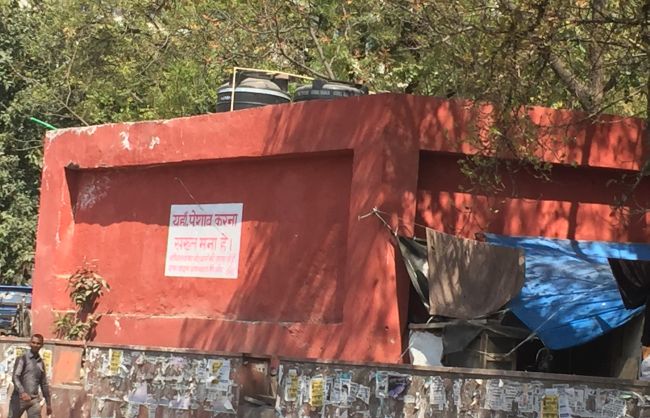Under a busy flyover close to many posh colonies in South Delhi, we met a 30-year-old Santara Devi. This has been her home for the last so many years now. She is one among the millions of homeless women across India who lives on the streets. Unlike many, she has access to 3 toilets, merely 40-steps away. Despite that, she and her family still defecate in the open. This is her story.
Community Toilet: 40 steps away
Cost: Rs. 5 per visit
Until 3 months ago, Santara Devi used to rely on a Community Toilet located in the vicinity. However, Rs. 5 is a very steep amount to shell out every time one needs to use a toilet. Moreover, the toilet is locked down at 9 pm every night. As a result of this, Santara Devi ended up using a discreet outdoor space close by whenever she needed to answer nature’s call.
About three months ago, the Delhi Urban Shelter Improvement Board (DUSIB) set up 2 new toilets for slum dwellers. However, things still did not change much for Santara Devi.
Also Read: Women With No Access To Toilets Prone To Rape: Study
Mobile Toilet – 40 steps away
Cost: Free of cost
At no cost instead of Rs. 5, the Delhi Urban Shelter Improvement Board’s Mobile Toilets are definitely more affordable, but still not accessible enough. While on paper, these show an addition of 2 more public toilets in Delhi, in reality not many people are using it. One of the toilets is locked and not functioning, while the other one stinks badly because of bad design.
Though the mobile toilets are open for use throughout the day and are free of cost, the 40 inhabitants living in this area prefers to go out and relieve themselves. When asked why their reason was simple – ‘Because these toilets smell so much.’
The mobile toilet is constructed in such a way that the waste is collected in a septic tank before it is transported to a nearby sewer line. However, the problem lies in the fact, that the waste gets accommodated in one area alone for long hours and takes the time to get transferred to the sewer line. The sewage from the toilet is only cleared every few days, making it a smelly, unhygienic option for those using it.
I prefer to go out and defecate in the open because after 9 pm the community toilet gets closed, and the one which remains open 24×7 – the mobile toilet has a very bad odour, says Santara Devi.
For a 17-year-old Aman Kumar, the problem is not odour but inaccessibility, he says, Most of the time, I prefer to go in the open because I don’t want to wait so long for doing the most basic thing – Pee. These new toilets are usually very crowded.
Also Read: Why ‘Swachh India’ Is The Biggest Women’s Movement At The Moment
The Ground Report

However, as Santara Devi’s story shows, merely building a toilet is not enough. To truly defeat the scourge of open defecation, toilets need to be maintained and the focus should be on design and quality as a good toilet design can encourage people to use toilets, whereas a bad toilet design can actually discourage them.
































